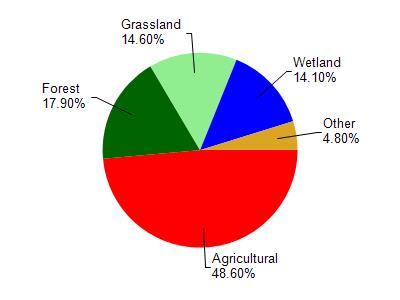Columbia
No
No
No
Fish and Aquatic Life
Overview
West Lake, in the Swan Lake Watershed, is a 18.16 acre lake that falls in Columbia County. This lake is managed for fishing and swimming and is currently not considered impaired.
Date 2011
Author Aquatic Biologist
Historical Description
A small landlocked kettle lake in marsh deposits in the ground moraine. The lake has clear moderately fertile water and a fishery for largemouth bass, panfish and northern pike. Abundant weed growth is a problem for fishing and the use of motorboats. Public access is not available. About 60 acres of wetland adjoin the lakeshore and extend to the nearby Fox River. Waterfowl nest and rest here. Source: 1965, Surface Water Resources of Columbia County West Lake, T12N, R10E, Sections 4, 5 Surface Acres = 18.8, S.D.F. = 1.07, Maximum Depth = 22 feet
Date 1965
Author Surface Water Inventory Of Wisconsin
Condition
Wisconsin has over 84,000 miles of streams, 15,000 lakes and milllions of acres of wetlands. Assessing the condition of this vast amount of water is challenging. The state's water monitoring program uses a media-based, cross-program approach to analyze water condition. An updated monitoring strategy (2015-2020) is now available. Compliance with Clean Water Act fishable, swimmable standards are located in the Executive Summary of Water Condition in 2018. See also the 'monitoring and projects' tab.
Reports
Management Goals
Wisconsin's Water Quality Standards provide qualitative and quantitative goals for waters that are protective of Fishable, Swimmable conditions [Learn more]. Waters that do not meet water quality standards are considered impaired and restoration actions are planned and carried out until the water is once again fishable and swimmable
Management goals can include creation or implementation of a Total Maximum Daily Load analysis, a Nine Key Element Plan, or other restoration work, education and outreach and more. If specific recommendations exist for this water, they will be displayed below online.
Monitoring
Monitoring the condition of a river, stream, or lake includes gathering physical, chemical, biological, and habitat data. Comprehensive studies often gather all these parameters in great detail, while lighter assessment events will involve sampling physical, chemical and biological data such as macroinvertebrates. Aquatic macroinvertebrates and fish communities integrate watershed or catchment condition, providing great insight into overall ecosystem health. Chemical and habitat parameters tell researchers more about human induced problems including contaminated runoff, point source dischargers, or habitat issues that foster or limit the potential of aquatic communities to thrive in a given area. Wisconsin's Water Monitoring Strategy was recenty updated.
Grants and Management Projects
Monitoring Projects
| WBIC | Official Waterbody Name | Station ID | Station Name | Earliest Fieldwork Date | Latest Fieldwork Date | View Station | View Data |
|---|
| 117100 | West Lake | 119077 | West Lake - Deep Hole | 5/18/2005 | 8/19/2006 | Map | Data |
| 117100 | West Lake | 10001163 | West Lake | 7/27/1999 | 9/22/2017 | Map | Data |
| 117100 | West Lake | 10015359 | West Lake - General Field Station | | | Map | Data |
|

Watershed Characteristics
West Lake is located in the Swan Lake watershed which is 80.61 mi². Land use in the watershed is primarily agricultural (48.60%), forest (17.90%) and a mix of grassland (14.60%) and other uses (18.90%). This watershed has 113.04 stream miles, 942.88 lake acres and 6,861.87 wetland acres.
Nonpoint Source Characteristics
This watershed is ranked Medium for runoff impacts on streams, Not Ranked for runoff impacts on lakes and High for runoff impacts on groundwater and therefore has an overall rank of High. This value can be used in ranking the watershed or individual waterbodies for grant funding under state and county programs.However, all waters are affected by diffuse pollutant sources regardless of initial water quality. Applications for specific runoff projects under state or county grant programs may be pursued. For more information, go to surface water program grants.